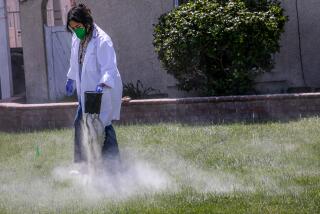Wood With Arsenic to Be Phased Out
- Share via
WASHINGTON — The Environmental Protection Agency announced Tuesday that arsenic-treated lumber--the green-tinted wood on decks and play sets across the country--will be phased out of the residential market over the next two years.
The voluntary decision by producers to pull the arsenic-treated lumber, known to most do-it-yourselfers as pressure-treated wood, off the market was the result of months of negotiations between the EPA and the companies that produce the pesticide.
The companies launched the talks in response to mounting pressure from environmentalists and consumers who fear that the ubiquitous product puts children at risk of developing cancer.
Scientists who have studied lumber treated with arsenic, a known human carcinogen, say children can be exposed to the toxin simply by touching the wood and then putting their fingers in their mouths. Repeated exposures increase the risk.
But the EPA, in announcing the decision to take the product off the market, confused the issue somewhat by saying that it has not concluded that arsenic-treated wood on decks, picnic tables and play sets poses “unreasonable risks to the public.”
The agency is reviewing the product and will publish a preliminary risk assessment next year. In the meantime, EPA officials said parents and homeowners do not need to replace decks or play sets made with the product or worry about the arsenic-treated lumber still for sale at lumber yards and in home-improvement stores.
Environmentalists, however, warned that arsenic levels in treated lumber are so high that parents should take steps to reduce the risk, such as applying an oil-based sealant or replacing the structure.
“The question now is what can millions of American families do with the thousands of square miles of highly hazardous arsenic-soaked lumber in their backyards,” said Jane Houlihan, a vice president of the Environmental Working Group, a Washington-based environmental research organization. “Children increase their cancer risk every time they play on this wood.”
Wood is pressure-treated with a pesticide to prevent infestation by insects and other microorganisms that can cause decay and structural problems.
Push to Reclassify It as Hazardous Waste
California State Sen. Gloria Romero (D-Los Angeles) is pushing legislation that would ban all arsenic-treated wood in California and reclassify the lumber as a hazardous waste that must be disposed of in special facilities.
“This is a dangerous product,” Romero said.
The EPA announcement marked a reversal by the pressure-treated wood industry, which had ardently defended the safety of its product in the face of growing criticism from environmental and consumer groups. Most major manufacturers of playground equipment already have shifted to treating their equipment with alternative pesticides or have announced plans to do so.
“It’s been an amazing turnaround over the last six months,” said Patrick Bischel, owner of Northern Crossarms, a Minnesota wood treatment company that switched to a different compound four years ago.
Environmental groups praised the withdrawal of the product but criticized the murky message that accompanied it.
“There’s a disconnect here,” said Paul Bogart, spokesman for Healthy Building Network, a coalition of architects, environmentalists and scientists. “If you’re a consumer, you don’t know what to think. You know it’s being taken off the market but you don’t know why.”
But EPA officials said the agency has not deciphered the conflicting data about the product-- chromated copper arsenate, or CCA--so it is premature to say whether it presents health risks.
“The hazard associated with arsenic is well known,” said Steve Johnson, head of the EPA’s pesticide office. “But the issue for CCA-treated lumber is: Is there any exposure occurring? Are children being exposed to the materials in CCA-treated lumber? At this point we don’t know.”
Response to Shifting Market Demands
The producers of chromated copper arsenate, the dominant preserver used in outdoor wood for 50 years, said they are phasing out the product in response to increased market demand for arsenic-free wood products. They insisted that arsenic-treated wood poses no danger to consumers.
But environmentalists called that position an obvious attempt to avoid lawsuits.
The product is still the mainstay in most lumber stores. Lumber treated with alternate substances usually must be special ordered.
The biggest sellers of arsenic-treated lumber--Lowes and Home Depot--said they will take their cues from the EPA.
Company representatives said the stores will begin stocking an alternative to arsenic-treated lumber as soon as it becomes available and will stop stocking arsenic-treated wood before the deadline.
About 350 plants across the country pressure-treat lumber. They will have to alter their facilities, at a cost of $40,000 to $200,000, to begin producing a non-arsenic alternative, said Parker Brugge, executive director of the American Wood Preservers Institute, the trade group for the industry.
An emerging alternative is wood treated with ACQ (alkaline, recycled copper and quat, a fungicide), which contains no carcinogens or other dangerous substances.
The EPA offered some guidance on the use of the pressure-treated wood: Never burn it, and wear masks and gloves when sawing it or working with it. Don’t put food directly on it.
Studies suggest that applying penetrating oil-based coatings to the treated wood reduces exposure to arsenic, said the EPA’s Johnson. But painting the wood with a product that may flake or peel is not a good idea because sanding it could dislodge more arsenic, he added.
“As always, when children play outside, whether around CCA-treated play structures or not, they should wash their hands prior to eating,” EPA said in a release.
Environmentalists also expressed concern about the disposal of arsenic-treated wood, which now is exempted from hazardous waste rules and can be thrown out anywhere. The arsenic can leach out into ground water and complicate efforts to reduce arsenic in drinking water.
More to Read
Sign up for Essential California
The most important California stories and recommendations in your inbox every morning.
You may occasionally receive promotional content from the Los Angeles Times.








